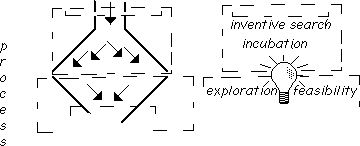By definition the truly original idea - the invention of new ways of looking at things - cannot be conceived of before its creation. And it is doubtful whether it could be predicted on the basis of performances in the systems of knowledge that it seeks to transform (paradigm shifts take quite some time to be accepted..in 1939 the NewYork Times stated: Television will never catch on, people don’t want to sit still so long.). The creative process can be studied through hindsight - through the reflections, observations of people whose ideas have already been acclaimed as acts of creativity.
The orderly pursuit of disorder
The creative thinking process can be divided into two stages: divergent thinking followed by convergent thinking. In the divergent stage a problem is formulated from various angles, worked and playfully approached. Many imaginative variations are considered for example, by means of free association. When divergent thinking is not acknowledged as such it may take place during rest or sleep (see dreaming).
As soon as creative people 'feel' that their divergent thoughts have accumulated enough information for solving a particular problem, they start the process of converging towards the right answer. Once the proper question has been formulated, the answer may be a matter of logical, experimental, mathematical and observational competence.

Getzels & Jackson (1962) have found that creative persons are good in making questions, i.e. were generally more original and flexible than others. According to their findings originality can be distinguished from intelligence. Intelligence tests tend to investigate the ability to give the 'required' answers. On basis of open question tests, which stimulated to imaginative stories, they concluded that although many students had the ability for divergent thinking, educational methods discouraged their use. And indeed one is hardly ever asked in class to formulate questions. Generally the divergent thinkers scored lower on intelligence tests than the convergent types.
Convergent thinkers have more respect for authority and low self-esteem, were less trustful of their feelings and intuition and behaved more mannered and controlled and mostly chose for the exact sciences. Divergent thinkers, on the other hand, showed less respect for authority, had more self-confidence and were more spontaneous and chose for the arts.
It would seem that the convergent thinker fits more in the stereotype of the scientist looking for technical solutions within existing patterns.
Thus an opposition is created which is quite unjust, for it is exactly the combination of divergence and convergence that is needed in creative thinking.
According to Frank Barron, who spent 30 years of his life studying creativity, we are dealing here with a paradox. Creative people have a predilection for the asymmetric, the incomplete and the unbalanced. There they feel a challenge to bring order. They let themselves be purposefully frustrated in order to be able to recreate situations in a new manner.
In our culture we have taken Aristotelian logic too literally. Aristotle stated: "It is impossible for the same thing at the same time to belong and not to belong to the same thing and in the same respect... This then is the most certain of all principles." (Aristotle, Metaphysics)
In opposition to Aristotelian logic is what might be called paradoxical logic, which assumes that A and non-A do not exclude each other as predicates of X.
Paradoxical logic was predominant in Chinese and Indian thinking, in Heraclitus' philosophy, and then again under the name of dialectics in the thought of Hegel and Marx. The general principle has been stated by Chuang-Tzu as: "That which is one is one. That which is not one, is also one."
In this thinking it is not impossible for one and the same person to strive for chaos and order at the same time. So when a systematic approach is followed in creative thinking this will at the same time include chaos, i.e. divergent thinking, associations with seemingly unconnected matters (random word provocation) or brainstorming.